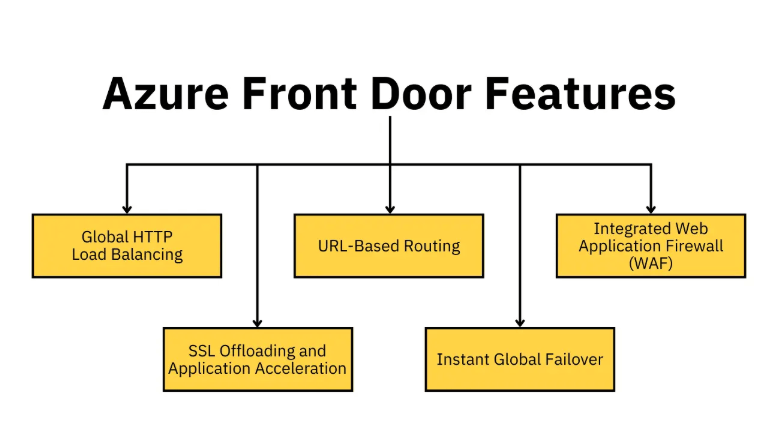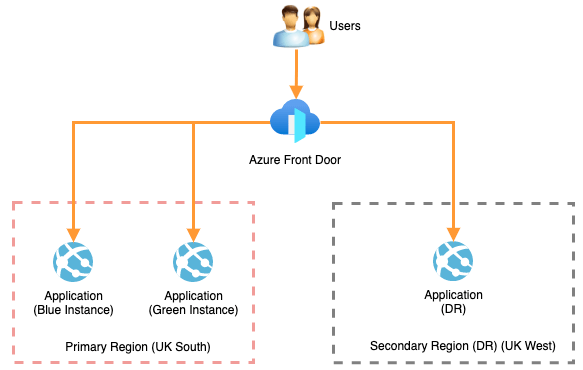
- Introduction to Azure Front Door
- What Makes Azure Front Door Stand Out?
- Key Features of Azure Front Door
- How Azure Front Door Works
- Benefits of Using Azure Front Door
- Azure Front Door vs. Azure Application Gateway: A Comparison
- Use Cases for Azure Front Door
- How to Set Up and Configure Azure Front Door
- Conclusion
Ready to Pursue Your Microsoft Azure Certificate? View The Microsoft Azure Course Offered By ACTE Right Now!
Introduction to Azure Front Door
Azure Front Door is a globally distributed, high-performance, and secure entry point for applications hosted on the cloud. It provides a scalable solution for web traffic management by offering features like load balancing, SSL termination, security at the edge, and global content delivery. It is a reverse proxy that routes incoming traffic to different backends while optimizing performance and reliability. Azure Front Door solves several challenges modern-day enterprises face in an era where users demand fast, reliable, and secure access to web applications from anywhere in the world. Whether you are running web apps, APIs, or media content, the Microsoft Azure Training ensures your services are globally accessible with low latency. Additionally, Azure Front Door, Azure Security provides real-time analytics, allowing you to monitor performance and troubleshoot issues. This ensures enterprises can maintain high availability and deliver optimized experiences to their users worldwide.
What Makes Azure Front Door Stand Out?
Azure Front Door differentiates itself from traditional web traffic management solutions by offering features that optimize application performance, security, and scalability. Here’s what sets it apart:
- Global Reach: Azure Front Door has a vast, globally distributed network of points of presence (PoPs), ensuring low-latency access to users worldwide.
- Single Entry Point: It consolidates multiple services such as load balancing, SSL termination, WAF (Web Application Firewall), and routing into a single platform, reducing complexity.
- Seamless Integration with Azure Ecosystem: Azure Front Door works seamlessly with other Azure services, such as Azure Application Gateway, Azure Content Delivery Network (CDN), Azure Security and Azure Web Apps.
- Advanced Traffic Routing: Using URL-based routing, session affinity, and health probes, Azure Front Door intelligently directs traffic to the best available backend.
- Customizable Security: With built-in AWS Web Application Firewall(WAF) protection, Azure Front Door can guard against common threats like DDoS attacks and application-layer vulnerabilities.
- High Availability: Azure Front Door ensures business continuity by distributing traffic across multiple regions, improving service reliability even during regional failures.
- Scalability: The platform automatically scales to handle varying traffic loads, ensuring optimal performance without the need for manual intervention.
- Real-Time Monitoring and Analytics: Azure Front Door provides detailed metrics and logs, helping you gain insights into performance, traffic patterns, and security incidents to enhance operational efficiency.
- Request Routing: Azure Front Door receives the request when a user accesses your domain.
- Traffic Distribution: Based on routing rules and load balancing policies, Front Door directs the request to one of the backend pools.
- Health Monitoring: If a backend pool is unresponsive, Azure Front Door reroutes traffic to a healthy backend.
- Edge Caching: Azure Front Door can cache content at edge locations for faster delivery to users, ensuring lower latency.
- Secure Access: SSL/TLS certificates are offloaded at the edge, ensuring secure communication between the client and Azure Front Door.
- Global Load Balancing: Complete Microsoft Azure course with Azure Front Door to automatically distribute traffic across multiple regions, ensuring high availability and improved performance for global users.
- Advanced Routing Rules: Traffic can be routed based on various factors like URL paths, HTTP headers, or session affinity, allowing for fine-grained control over how requests are handled.
- Web Application Firewall (WAF) Protection: Azure Front Door inspects incoming traffic for security threats, blocking malicious requests and protecting your application from vulnerabilities like SQL injection or cross-site scripting (XSS).
- Automatic Failover: In the event of a backend failure or degradation in performance, Azure Front Door quickly redirects traffic to the most reliable backend, ensuring uninterrupted service for end users.
- Real-Time Traffic Monitoring: Azure Front Door provides insights into traffic patterns and backend health, enabling administrators to monitor performance, identify bottlenecks, and troubleshoot issues in real time.
- Create a Front Door Instance: Go to the Azure portal and create a new Front Door instance. Provide a name and select a resource group.
- Add Frontend Host: Configure the frontend domain (custom domain or default). This is the URL that your users will access.
- Add Backend Pools: In the Azure administrator certification article , you learn how to define backend servers or services that handle incoming traffic. These can be Azure App Services, VMs, or external resources.
- Set Routing Rules: Create rules for routing traffic. You can set up URL-based routing, session affinity, or load-balancing policies.
- Enable Web Application Firewall: Optionally, you can configure the WAF to protect your application from security threats.
- Configure SSL: If you want to secure your traffic, configure SSL certificates and enable SSL offloading.
- Monitor and Optimize: Use Azure Monitor to track performance and traffic patterns, making adjustments as necessary.
Excited to Obtaining Your Microsoft Azure Certificate? View The Microsoft Azure Training Offered By ACTE Right Now!
Key Features of Azure Front Door
Azure Front Door has several features that make it a robust solution for web application delivery. Some key features such as Azure Front Door supports global HTTP/HTTPS load balancing with automatic failover, ensuring your users always have access to the application, even during failures. With SSL termination at the edge, Azure Front Door offloads SSL/TLS processing, improving the performance of backend systems. It includes built-in protection from common web vulnerabilities, such as SQL injection and cross-site scripting (XSS). Azure Front Door allows you to configure and manage custom domains securely and efficiently. With detailed monitoring and logging, you can gain real-time insights into your application’s traffic patterns and security issues.

Azure Front Door evaluates the health of your backends and routes traffic to the best-performing server, improving the end-user experience. Azure Front Door intelligently routes traffic based on the geographical location of users, ensuring faster response times and optimized performance for global audiences. Azure Front Door offers advanced routing based on URL paths, allowing for precise traffic management to different services or backends based on specific application requirements. With integrated caching capabilities, Azure Front Door, along with Azure Devops, can reduce the load on backend servers and accelerate content delivery by storing static content at the edge. Azure Front Door provides built-in protection against Distributed Denial of Service (DDoS) attacks, Azure Security safeguarding your applications from malicious traffic while ensuring availability during high-demand periods.
How Azure Front Door Works
Azure Front Door works by sitting between the end-users and the backend servers or services. When users request content from your application, their requests are directed to the nearest Azure Front Door PoP. From there, it intelligently routes the traffic to the most optimal backend, whether a backend hosted within Azure or on-premises. The process involves several steps:
Exploring Options for Microsoft Azure Master’s Degree? Enroll For Microsoft Azure Master Course Today!
Benefits of Using Azure Front Door
Azure Front Door benefits organizations looking to scale their web applications, enhance performance, and secure their services. Azure Front Door reduces latency by routing traffic through the nearest PoP and offloading SSL processing, ensuring faster end-user response times. It provides automatic scalability with global traffic distribution and load balancing, allowing your application to handle a surge in traffic without manual intervention. With features like WAF, DDoS protection, and SSL termination, Azure Front Door provides robust security against malicious traffic and attacks. Consolidating multiple services like load balancing, routing, and firewall into one platform simplifies infrastructure management and reduces operational complexity. Microsoft Azure Training covers how Azure Front Door ensures high availability by automatically rerouting traffic in the event of a failure, ensuring that your application is always accessible. Azure Front Door’s vast network of Points of Presence (PoPs) ensures that users from anywhere in the world experience low-latency access and fast response times. With URL-based routing, session affinity, and health probes, Azure Front Door intelligently directs traffic to the most optimal backend, improving application performance and user experience. Azure Front Door provides detailed analytics and logging, giving you visibility into traffic patterns, performance metrics, and security events, helping you quickly identify and resolve issues. Azure Front Door integrates easily with other Azure services like Azure CDN, Application Gateway, Azure Security and Web Apps, creating a seamless experience for managing your cloud-based applications.
Azure Front Door vs. Azure Application Gateway: A Comparison
Azure Front Door and Azure Application Gateway are popular for routing traffic to web applications but serve slightly different purposes. Here’s a comparison:
| Feature | Azure Front Door | Azure Application Gateway |
|---|---|---|
| Global Load Balancing | Yes, with global traffic routing | Limited to regional load balancing |
| SSL Offloading | Yes, at the edge | Yes, but only within a region |
| Web Application Firewall | Yes, integrated | Yes, integrated |
| Traffic Routing | URL-based, based on performance and health | Path-based, application-layer routing |
| Performance Optimization | Global distribution, low latency | Localized traffic management, more regional |
| Pricing | Based on global traffic and PoP usage | Based on throughput and instance size |
| Ideal Use Cases | Global applications needing fast, secure access | Applications that need more granular, regional control |
| Scalability | Automatically scales globally to handle traffic surges | Scales within a specific region, with manual scaling options |
| Integration with Other Azure Services | Seamlessly integrates with services like Azure CDN, Web Apps, and Azure Functions | Integrates well with Azure Virtual Networks (VNets) and other regional services |
| Session Affinity | Supports session affinity based on user behavior and performance metrics | Supports session affinity within a region |

In summary, Azure Front Door is suitable for global, high-performance applications, while Azure Application Gateway is better suited for applications that need more localized traffic management and regional scaling.
Use Cases for Azure Front Door
Azure Front Door is a versatile service that can be applied in various use cases. Applications that require fast and secure access from anywhere in the world can leverage Azure Front Door for low-latency delivery. Azure Front Door is perfect for hybrid cloud scenarios in which some parts of the application reside in Azure while others are hosted on-premises or in a different cloud. With built-in caching and content delivery optimization, Azure Front Door can accelerate content delivery for static assets like images, videos, and documents, benefiting those pursuing a Certified Azure Developer credential. Azure Front Door ensures optimal performance and reliability for e-commerce sites that experience heavy traffic spikes during seasonal events or sales. Azure Front Door’s advanced routing capabilities make it an excellent choice for routing requests between microservices in a distributed architecture. Azure Front Door provides automatic traffic rerouting in case of a failure, ensuring business continuity and high availability for critical applications across multiple regions. Azure Front Door serves as an effective global API gateway, providing secure and optimized access to APIs, enabling low-latency communication between clients and backend services across different regions. Azure Front Door is ideal for multinational organizations with a global user base, ensuring that users across different regions experience fast, secure, and reliable access to applications and services.
Preparing for Your Microsoft Azure Interview? Check Out Our Blog on Microsoft Azure Interview Questions & Answer
How to Set Up and Configure Azure Front Door
Setting up Azure Front Door involves several key steps. Here’s an overview of the process:
Conclusion
Azure Front Door is a powerful solution for managing web traffic in a global, scalable, and secure manner. Its advanced features like global load balancing, SSL offloading, WAF, and real-time traffic analytics provide an optimal solution for delivering high-performance web applications. Whether you’re building an international e-commerce platform, a content delivery network, or a hybrid cloud application, Azure Front Door ensures your services are secure, fast, and always available. By implementing Azure Front Door as part of a Microsoft Azure Training , businesses can simplify their infrastructure, improve performance, and provide a superior experience to users worldwide. As web traffic continues to grow and evolve, leveraging the power of Azure Front Door will help ensure that your applications remain competitive, secure, and efficient in a dynamic digital landscape.





